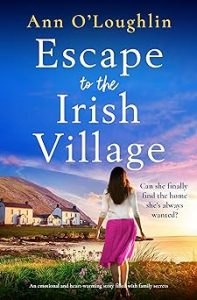Writing Dialogue
The best way to write realistic dialogue? Become a champion eavesdropper. Dialogue should flow from the page. Here are my three must dos.
- Listen to everybody, all the time and everywhere.
- Concentrate on voice and tone.
- Take in the rhythm of real life conversation.
Bestselling Irish author, Maeve Binchy freely admitted that she was a compulsive and expert ear wigger, and we all know her dialogue was superb.
Other people’s conversations nearly always seem more interesting. I know of one writer who has gone past her stop on the commuter train more than once, because she got so engrossed in a conversation going on across the aisle.
In my job as a journalist, I am lucky I get to listen to people talking all the time. It is only by listening that you tune in to the person. It’s often not what they say, but the way they say it. You tune in to the music of the voice, pick out the nuances in the speech.
There are many rules around dialogue, but I believe in listening to others. Talking is the best teacher.
Have you ever heard anyone impart so much background information that they don’t stop for air, or an upset child explain in detail what is wrong? I didn’t think so.
Does the person weighed down by grief manage complete and perfect sentences?
Exactly, that person stops and stutters as grief overcomes.
We are all different, and the way we speak and express ourselves is individual. For some it is the loud and brash; for others, the delight is what remains unsaid or implied.
I first learned of the importance of the descriptive powers of language as a young journalist covering the criminal trial of a man charged with breaking into an elderly man’s house on a bleak and harsh mountain in the west of Ireland. The pensioner was terrorised and robbed of his life savings.
He survived the attack and was able to go into the witness box, and give evidence.
He spoke in a soft accent about his farm and his parents who had farmed the land before him. He had thousands in bank notes stuffed into a mattress because he didn’t trust banks.
When it came to the night of the break in, the elderly man gave his evidence in a measured way.
Asked how he knew somebody was in his house he said: ‘I felt the cold of the wind blowing up the stairs, and I knew somebody had opened the back door.’
His use of language was beautiful and descriptive, and was a sharp contrast to the words of his attacker who beat him up that night.
That farmer spoke his truth. Good dialogue isn’t just what people say, it about how they say it. The writer must listen to how sentences are formed. A young person is not going to talk like an elderly person ,and a child is not going to spend a long time explaining.
The challenge in my latest novel Escape to the Irish Village in relation to dialogue was the different age groups of the characters. One of the main characters is a wonderful 75-year old woman and owner of Killcawley Estate, Judith, who in her own words ‘ doesn’t do old” loves fashion, has a TikTok account and befriends Emma who is in her twenties. This is them chatting soon after they met.
When Judith returned to the car, she was scowling.
‘Why is it when you reach a certain age, everybody thinks you are a doddery old fool. The clerk had the cheek to ask me why I wanted so much in cash, and when I wouldn’t tell her, she called the manager. Of course, it was a pimply twenty something – no offence – who spoke to me in a raised voice and deliberately slow. He said he was the new manager and wanted to look out for all his customers. He asked me if I was under any duress.’
‘What did you do?’
Judith laughed. ‘I told him look up my balance, which is not insignificant. As he looked at the screen, I told him if he wanted to remain a bank manager past this week, he would treat me with respect and realise I can make my own banking decisions.’
‘He may have just be looking out for you,’ Emma said.
Judith turned to her. ‘And I am a touchy old bird, I know, but I didn’t close my accounts and that’s thanks enough.’
We know dialogue can be used to introduce tension. It can also provide an opportunity for some much needed humour.
Here is an exchange between Judith and her oldest friend Marsha about TikTok:
Judith stopped. ‘A marvellous job, Marsha. I couldn’t have such a high profile, but for you.’
‘High profile my ass. Sure, who looks at that TikTok anyway?’
Judith guffawed. ‘You go ask any young person and they’ll tell you you’re nobody if you’re not on TikTok. Sure, China probably has a file on me in Beijing…’
Marsha pulled out a chair at the table and sat down. ‘Well, I hope they record that you have a big, fat head,’ she muttered, and Emma sniggered..
Judith swung around behind Marsha’s chair and landed a kiss on her head. ‘She loves me, really. And, unlike a lot of her other customers, I always pay on time. We are also the best of friends, have been forever.’
‘There’s that,’ Marsha said.
Savour the one liners and the snatches of gossip you hear on the tram, on the train , on the bus or in the supermarket as couples bicker over luxuries and children pester for all things sweet. These are the lines that will come back as you write your dialogue.
Happy listening and writing.
Ann.
—
 Bestselling author Ann O’Loughlin is also a leading journalist in Ireland, Ann has covered all major news events of the last three decades. She spent most of her career with Independent Newspapers and is now a senior journalist with the Irish Examiner newspaper. Ann has also lived in India. Originally from the west of Ireland she now lives on the east coast with her husband and two children. Ann’s novels have been translated into eleven languages. Escape to the Irish Village is Ann’s eight novel.
Bestselling author Ann O’Loughlin is also a leading journalist in Ireland, Ann has covered all major news events of the last three decades. She spent most of her career with Independent Newspapers and is now a senior journalist with the Irish Examiner newspaper. Ann has also lived in India. Originally from the west of Ireland she now lives on the east coast with her husband and two children. Ann’s novels have been translated into eleven languages. Escape to the Irish Village is Ann’s eight novel.
Find Ann
FACEBOOK @annoloughlinbooks
TWITTER @annolwriter
INSTAGRAM @authorannoloughlin
And TikTOK
ESCAPE TO THE IRISH VILLAGE
 Can she finally find the home she’s always wanted?
Can she finally find the home she’s always wanted?
Emma Wilson is running from a broken marriage after her life has been torn apart, and she’s desperate to start over. Escaping to a small Irish village, Emma begins working for seventy-five-year-old fashion enthusiast Judith McCarthy in her beautiful manor house at the heart of the tight-knit community. The quirky locals give Emma a warm welcome and, inspired by Judith’s passion for life, Emma hopes she can rebuild her life in this village by the sea.
As Emma and Judith’s lives intertwine, Emma meets Judith’s brooding son Miles. At first, the two argue over everything, clashing over decisions about the estate and how to support Judith. But when Emma begins to see a different side to Miles – a hardworking man who will do anything for his family – she can’t deny the attraction between them. But can she open her heart and love again?
Soon Emma realises that Judith’s bold spirit is hiding deeper troubles. The village that means so much to them both is in danger of being destroyed, and protecting their home will be the biggest challenge of Judith’s life. It seems the two women have been thrown together when they need each other most…
BUY HERE
Category: How To and Tips























